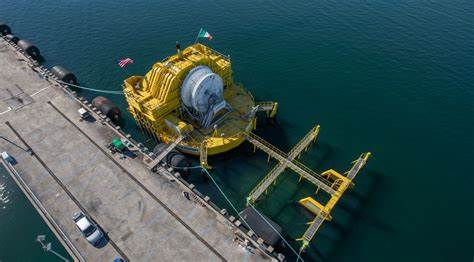
Introduction
The vastness of space has always fascinated and intrigued mankind. Over the years, space exploration has evolved significantly, enabling us to delve deeper into the mysteries of the universe. However, as we venture further into space, the need for sustainable and renewable sources of energy becomes increasingly crucial. This is where the concept of ocean energy in space exploration comes into play. By harnessing the power of the ocean, we can fuel our space missions and pave the way for a sustainable future beyond Earth.
Historical Background
Space exploration has a rich history filled with groundbreaking discoveries and technological advancements. From the first human landing on the moon to robotic missions exploring distant planets, our understanding of space has expanded exponentially. Interestingly, early research and experiments related to space exploration also had connections to ocean energy. Scientists recognized the potential of the ocean as a vast source of renewable energy, and its exploration became an integral part of space missions. Over time, our understanding of ocean energy has evolved, driving us to explore its potential in new and innovative ways.
Key Concepts and Definitions
To fully grasp the potential of ocean energy in space exploration, it is important to understand key terms and concepts. Ocean energy refers to the various forms of energy that can be harnessed from the ocean, including tidal, wave, and ocean thermal energy conversion (OTEC). Each of these forms offers unique advantages and challenges when it comes to their utilization in space missions. Tidal energy, for instance, involves harnessing the gravitational forces of the moon and the sun to generate power. Wave energy, on the other hand, taps into the energy created by the motion of ocean waves. OTEC utilizes the temperature difference between warm surface waters and deep cold waters to produce electricity. By exploring these concepts, we can uncover the potential benefits and challenges associated with harnessing ocean energy in space.

Main Discussion Points
Point: The potential of tidal energy in space exploration
Tidal energy has emerged as a promising source of renewable power for space missions. By harnessing the gravitational forces of celestial bodies, such as the moon, we can generate a consistent and reliable source of energy. Tidal energy can be harnessed through technologies such as tidal turbines or tidal barrages. However, there are both advantages and disadvantages associated with using tidal energy in space missions. While the predictability of tides ensures a constant energy supply, the high initial costs and potential environmental impacts need to be carefully evaluated. Nonetheless, tidal energy has already been utilized in space missions, such as the European Space Agency’s lunar mission, providing a glimpse into its potential.
Point: The potential of wave energy in space exploration
Wave energy presents another exciting opportunity for powering space missions. The continuous motion of ocean waves offers a renewable and abundant source of energy. By capturing this energy through technologies like wave energy converters, we can generate electricity to meet the energy demands of space missions. However, harnessing wave energy in space exploration comes with its own set of challenges and opportunities. The unpredictable nature of waves and the harsh marine environment pose technical and logistical hurdles. Nonetheless, wave energy has been considered for space missions, with studies and experiments indicating its viability.
Point: The potential of ocean thermal energy conversion (OTEC) in space exploration
Ocean thermal energy conversion (OTEC) has gained attention as a potential solution for generating clean energy in space. OTEC utilizes the temperature difference between warm surface waters and cold deep waters to drive a heat engine and produce electricity. While OTEC holds promise, its implementation in space missions presents significant technical challenges. The need for large infrastructure and the requirement of a suitable thermal gradient limit its feasibility. However, exploring the potential applications and benefits of OTEC in future space exploration missions is essential to unlock its full potential.
Point: Other forms of ocean energy in space exploration
Beyond tidal, wave, and OTEC, there are other forms of ocean energy that hold potential for space exploration. Salinity gradient energy, for example, involves harnessing the energy created by the difference in salt concentration between freshwater and seawater. Additionally, ocean currents offer a continuous flow of energy that can be tapped into. While these forms of ocean energy are still in the early stages of research and development, they show promise and could become valuable sources of renewable energy for future space missions.
Case Studies or Examples
Real-world examples and case studies provide valuable insights into the practical applications of ocean energy in space exploration. One such example is the European Space Agency’s lunar mission, where tidal energy was utilized to power the lunar base. This successful implementation demonstrated the viability of tidal energy in space missions. Additionally, ongoing research and experiments exploring the use of wave energy in space missions provide valuable lessons and outcomes that can shape future endeavors.
Current Trends or Developments
The field of ocean energy in space exploration is constantly evolving, with recent trends and developments paving the way for innovative solutions. Advancements in technology, such as more efficient wave energy converters and improved materials for tidal turbines, are being explored. Furthermore, new approaches, such as hybrid systems combining different forms of ocean energy, are being investigated to maximize energy generation in space missions. Staying abreast of these trends and developments is crucial to unlock the full potential of ocean energy in space exploration.
Challenges or Controversies
As with any emerging field, the use of ocean energy in space exploration faces challenges and controversies. Differing viewpoints and debates surround the environmental impact of harnessing ocean energy and the potential disruption to marine ecosystems. Ethical considerations, such as the equitable distribution of resources and the impact on local communities, need to be carefully addressed. Additionally, legal frameworks and regulations surrounding the use of ocean energy in space missions require careful consideration and development.
Future Outlook
The future of ocean energy in space exploration holds immense promise. Emerging technologies and ideas, such as advancements in energy storage systems and the integration of renewable energy sources, could revolutionize space missions. The continued exploration and research in this field will pave the way for a sustainable and renewable future beyond Earth. By harnessing the power of the ocean, we can ensure a sustainable energy supply for space missions while minimizing our impact on the environment.
Conclusion
Ocean energy has the potential to revolutionize space exploration by providing a sustainable and renewable source of power. Tapping into the various forms of ocean energy, such as tidal, wave, and OTEC, offers unique opportunities and challenges. Real-world examples and ongoing research highlight the viability and potential of ocean energy in space missions. However, addressing challenges, controversies, and ethical considerations is essential for responsible and sustainable implementation. With constant advancements and a future-focused outlook, ocean energy in space exploration can shape the way we explore and inhabit the cosmos.